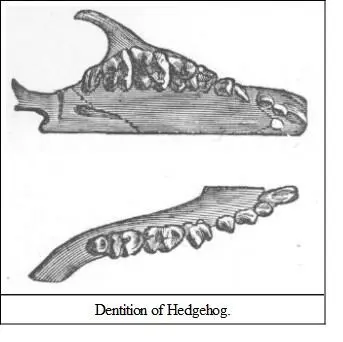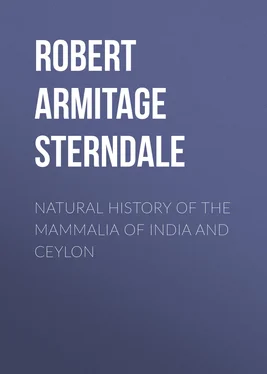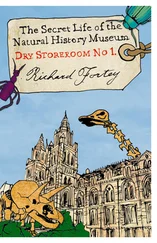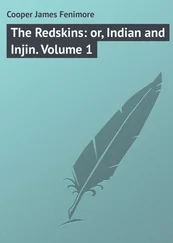Robert Armitage Sterndale - Natural History of the Mammalia of India and Ceylon
Здесь есть возможность читать онлайн «Robert Armitage Sterndale - Natural History of the Mammalia of India and Ceylon» — ознакомительный отрывок электронной книги совершенно бесплатно, а после прочтения отрывка купить полную версию. В некоторых случаях можно слушать аудио, скачать через торрент в формате fb2 и присутствует краткое содержание. Жанр: foreign_edu, Биология, на английском языке. Описание произведения, (предисловие) а так же отзывы посетителей доступны на портале библиотеки ЛибКат.
- Название:Natural History of the Mammalia of India and Ceylon
- Автор:
- Жанр:
- Год:неизвестен
- ISBN:нет данных
- Рейтинг книги:5 / 5. Голосов: 1
-
Избранное:Добавить в избранное
- Отзывы:
-
Ваша оценка:
- 100
- 1
- 2
- 3
- 4
- 5
Natural History of the Mammalia of India and Ceylon: краткое содержание, описание и аннотация
Предлагаем к чтению аннотацию, описание, краткое содержание или предисловие (зависит от того, что написал сам автор книги «Natural History of the Mammalia of India and Ceylon»). Если вы не нашли необходимую информацию о книге — напишите в комментариях, мы постараемся отыскать её.
Natural History of the Mammalia of India and Ceylon — читать онлайн ознакомительный отрывок
Ниже представлен текст книги, разбитый по страницам. Система сохранения места последней прочитанной страницы, позволяет с удобством читать онлайн бесплатно книгу «Natural History of the Mammalia of India and Ceylon», без необходимости каждый раз заново искать на чём Вы остановились. Поставьте закладку, и сможете в любой момент перейти на страницу, на которой закончили чтение.
Интервал:
Закладка:
HABITAT.—Darjeeling.
DESCRIPTION.—Deep blackish brown, very slightly rufescent in certain lights; tail slender, nearly naked, very slightly attenuated, compressed at the tip.
SIZE.—Head and body, 2½ inches; tail 2½ inches.
This is identical with the European Alpine shrew; the Sorex caudatus of Horsfield's Catalogue (No. 148), which was a specimen named by Hodgson, is also the same animal.
Remarkably for its large head, nude, scaly extremities, and extremely short, nude, scaly tail. "The structure of the ear, limbs and tail has special reference to a burrowing animal—the ear being valvular, so that it may be effectually closed against the entrance of foreign substances, and the feet devoid of hair, but scaly, and the tail reduced to very small dimensions. The eye is also excessively small, and buried deep in the dense silky fur. The hind feet, contrary to what is almost invariably the case in burrowing mammals, are larger than the fore feet."— Anderson .
HABITAT.—Assam, Thibet.
DESCRIPTION.—General colour dark slaty, faintly washed with brownish rusty on the long hairs of the rump; fur long and silky, longest over the rump; occasional long brown hairs with pale tips are scattered over the body; long whiskers, yellow claws; naked parts of snout, limbs and tail flesh-coloured.
SIZE.—Head and body nearly 3 inches; tail, ½ inch; forefoot, ½ inch; hind foot, ¾ inch.
The skull and dentition of this animal are essentially soricine. The Thibetan species ( A. squamipes ) is described as being over four inches in length, of a greyish colour, with a greenish-brown tinge; feet and nails whitish. It lives in burrows which it digs in the earth. I think it should properly come after the moles, which it resembles in some particulars.

The molar teeth broad; the hinder ones nearly square, the tubercles on their upper surface rounded; the other teeth are three incisors on each side, of which the inner one is considerably larger than the rest; behind these, separated by a little gap, come three premolars gradually increasing in size, then one having much the appearance of a true molar, but furnished with a cutting edge; then three molar teeth, two of which are nearly square with strong tubercles. The last molar is small. In the lower jaw the lowermost incisor is very large, and projects almost horizontally forwards, and it is followed by three small teeth now acknowledged to be premolars, with another large premolar, which is of the nature of a carnassial or cutting tooth acting on the one in the upper jaw. Then three molars as above, two large and one small, but with sharp tubercles. The skull has a more carnivorous form; it has "a complete zygomatic arch, and the tympanic bone forms a bundle-like swelling on each side of the back of the skull." Feet pentadactylous or five-toed; legs very short. The tibia and fibula (two bones of the shank) are joined together. The back is clothed with hair intermixed with sharp spines or bristles. Tail short or wanting entirely.
The European hedgehog is well known to most of us. Few boys who have lived a country life have been without one at some time or other as a pet. I used to keep mine in a hole at the root of an old apple-tree, which was my special property, and they were occasionally brought into the house at the cook's request to demolish the black-beetles in the kitchen. These they devour with avidity and pursue them with the greatest ardour. They also eat slugs, worms, and snails; worms they seize and eat from end to end, like a Neapolitan boy with a string of maccaroni, slowly masticating, the unconsumed portion being constantly transferred from one side of the mouth to the other, so that both sides of the jaws may come into play. Dr. Dallas quaintly remarks on the process: "This must be an unpleasant operation for the worm, much as its captor may enjoy it." Toads, frogs, mice, and even snakes are eaten by the European hedgehog. It would be interesting to find out whether the Indian hedgehog also attacks snakes; even the viper in Europe is devoured by this animal, who apparently takes little heed of its bite. The European species also eats eggs when it can get them, and I have no doubt does much damage to those birds who make their nests on the ground.
Few dogs will tackle a hedgehog, for the little creature at once rolls itself into a spiny ball, all sharp prickles, by means of the contraction of a set of cutaneous muscles, the most important of which, the orbicularis panniculi , form a broad band encircling the body which draws together the edges of the spiny part of the skin. There is a most interesting account of the mechanism of the spines in Mr. F. Buckland's notes to White's 'Natural History of Selborne,' vol. ii., page 76. A jet of water poured on to the part within which the head is concealed will make the creature unroll, and it is said that foxes and some dogs have discovered a way of applying this plan, and also that foxes will roll a hedgehog into a ditch or pond, and thus make him either expose himself to attack or drown. Gipsies eat hedgehogs, and consider them a delicacy—the meat being white and as tender as a chicken (not quite equal to porcupine, I should say); they cook them by rolling them in clay, and baking them till the clay is dry; when the ball is broken open the prickles come off with the crust.

Hedgehogs have had several popular fallacies concerning them. They were supposed to suck cows dry during the night and to be proof against poisons. Mr. Frank Buckland tried prussic acid on one with fatal results, but he says the bite of a viper seemed to have no effect. Pallas, I know, has remarked that hedgehogs will eat hundreds of cantharides beetles with impunity, whereas one or two will cause extreme agony to a cat or dog. The female goes with young about seven weeks, and she has from three to eight in number. The little ones when born have soft spines—which, however, soon harden—are blind, and, with the exception of the rudimentary prickles, quite naked. They are white at birth, but in about a month acquire the colour of the mother.
HABITAT.—Northern India and Afghanistan. Dallas says from Madras to Candahar; but Jerdon calls it the North Indian hedgehog, and assigns to it the North-west, Punjab, and Sind, giving Southern India to the next species.
DESCRIPTION.—Spines irregularly interwoven, ringed with white and black, with yellowish tips, or simply white and black, or black with a white ring in the middle; ears large; chin white; belly and legs pale brown.
SIZE.—Head and body, 8 to 9 inches; tail, 7/12 inch.
I have found this species in the Punjab near Lahore. One evening, whilst walking in the dusk, a small animal, which I took to be a rat, ran suddenly between my legs. Now I confess to an antipathy to rats, and, though I would not willingly hurt any animal, I could not resist an impulsive kick, which sent my supposed rat high in the air. I felt a qualm of conscience immediately afterwards, and ran to pick up my victim, and was sorry to find I had perpetrated such an assault on an unoffending little hedgehog, which was however only stunned, and was carried off by me to the Zoological Gardens. Captain Hutton writes of them that they feed on beetles, lizards, and snails; "when touched they have the habit of suddenly jerking up the back with some force so as to prick the fingers or mouth of the assailant, and at the same time emitting a blowing sound, not unlike the noise produced when blowing upon a flame with a pair of bellows." He also says they are very tenacious of life, bearing long abstinence with apparent ease; when alarmed they roll themselves up into a ball like the European species.
Читать дальшеИнтервал:
Закладка:
Похожие книги на «Natural History of the Mammalia of India and Ceylon»
Представляем Вашему вниманию похожие книги на «Natural History of the Mammalia of India and Ceylon» списком для выбора. Мы отобрали схожую по названию и смыслу литературу в надежде предоставить читателям больше вариантов отыскать новые, интересные, ещё непрочитанные произведения.
Обсуждение, отзывы о книге «Natural History of the Mammalia of India and Ceylon» и просто собственные мнения читателей. Оставьте ваши комментарии, напишите, что Вы думаете о произведении, его смысле или главных героях. Укажите что конкретно понравилось, а что нет, и почему Вы так считаете.












